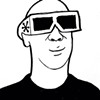Published June 2, 2004 at 4:00 a.m.
It's a Saturday evening and I'm standing barefoot in a Franklin County field with a dozen other unshod women and men. It's dark, and we're holding hands in a circle, chanting. In a few minutes, those of us who want to will be walking on hot coals. I feel as if I should be in Fiji or India, flanked by fakirs and readying my soul for purification. But the locale is Fairfax, my co-chanters have day jobs ranging from acupuncturist to AmeriCorps, and the path I'm readying my soles for is strictly secular. We're nearing the final, scorching steps of a workshop offered by Sarah Bolton, certified firewalking instructor.
At the center of our configuration, a man and a woman rearrange a bonfire, readying it for the walk. Grimacing and ducking their heads in the heat, they use a long-handled rake and a shovel to push the uneven ember-ridden remains of birch logs to one side, then pat the remaining briquet-sized coals into a long, rectangular strip. When they're finished, an eight-foot smoldering sidewalk is etched in the damp lawn. At its edges, blades of grass wither from the heat, shrinking like singed hair. The rake and shovel, cooling in a basin of water, emit sharp twin hisses.
Once she puts her shovel down, the woman joins the circle and declares the fire "open." My throat constricts and my chanting dies to a sorry gurgle.
When I first heard about firewalking in Vermont, I was surprised, but I shouldn't have been. Firewalks have become popular in the past 30 years, glowing everywhere from corporate seminars to summer camps. Bolton is amply qualified to preside over our coal bed. She's a 27-year-old massage therapist, ropes-course instructor and assistant chiropractor who was trained at the Firewalking Institute of Research and Education by the "father of fire-walking in America." Tolly Burkan and his then-wife Peggy Dylan developed the core seminar that shapes the lessons offered by F.I.R.E instructors today.
Over the phone earlier in the week, Bolton described the firewalk as an opportunity to "realize our power." The practice appeals to her for the same reasons she's attracted to the ropes course: She's interested in getting people in touch with their full potential, and dealing with fear is a part of that process. "It's not my place to dispel that fear, but to change the relationship to it," Bolton told me.
In advance of my own walk, I also talked to another F.I.R.E.-certified instructor, Maura Cullen, who will be leading a workshop at Bolton later this month. Cullen, who has been a sky diver, sees the firewalk as a valuable tool for experiential learners. As a long-time counselor and diversity-workshop leader, she's keenly aware that what goes on in the mind matters. "What people say to you can be hurtful," she pointed out. "But what you tell yourself can be devastating."
What you tell yourself can also give you the oomph to get where you want to go, she said. Cullen worked on a book for 10 years, but was unable to summon the determination and confidence to complete it. After attending a firewalk last September, she attacked the project and got it done. Now she's in search of a publisher.
Firewalk instructors and veterans believe the stroll across the coals is a kind of reprogramming short-cut that enables people to make dramatic changes in their lives. It gets people to realize that their limits are more flexible than they might have imagined. "If we can walk over hot coals and not burn our feet," Cullen mused, "what else are we capable of doing?"
The attention necessary for this kind of self-help is considerable, and that's where the firewalk comes in, Cullen said. "When you're faced with a bed of coals at 1200 degrees Fahrenheit, it's amazing how much you'll focus."
No one disputes that walking over fire unscathed is possible -- the bulk of participants in the U.S. have crisscrossed coals without significant injury. The disagreements arise over how it is possible. Skeptics focus on physics. One theory says that evaporating moisture from the bottom of the foot forms a vaporous shield that keeps feet from direct contact with the coals. The so-called Leiden-frost Effect can be observed in the skittering of a drop of water on a sufficiently hot frying pan; it takes longer to evaporate than when it is in direct contact with the pan at lower temperatures. Others claim that coals are poor conductors of heat.
Neither argument seems to fully explain firewalking, as Burkan argues on his website. The Leidenfrost Effect does not always seem to work, as some walkers do get blisters and burns on their feet. The real variable, many instructors argue, is in the human mind.
The hours leading up to the Fairfax firewalk are spent coasting through concepts like "FEAR = False Evidence Appearing Real"; "Pay Attention... to what's really going on"; and "Expect the Best." We bend steel rebar with our necks and are encouraged to listen to our inner voices. Maps of the foot's reflexology regions are passed out, along with waiver forms. The lessons presented seem significant but vague, and they skitter briefly through my brain before evaporating, like a Leidenfrosty water droplet on a primed frying pan.
"There's really no practical application for walking on fire," Bolton says, just before we head out to the waiting coals. "It's not about walking on the fire; it's about listening to your inner voice." If that inner voice is screaming at you to not step on the coals, it's good to heed that advice and not step on the coals. But that's a valuable exercise, Bolton reassures us. "Even if you just watch people, you're going to have an amazing experience."
On my way to the fire my confidence dissolves. I begin clutching and releasing the pens in my pocket apprehensively. I watch as two women walk briskly across the coals. The first is grim-faced, the second serene. Their footprints glow bright orange. A minute later I'm taking my own fiery steps.
Either I'm not focusing properly or I'm feeling conflicted -- not having fully committed to physics or psychology -- but four steps into the glowing coal bed, it hits me: Ow! Hot! SHIT! I bite my lip and continue across, jumping into a pan of water at the opposite end.
Poker-faced, I rejoin the circle and keep chanting, now slightly off-key. After a few minutes I turn my feet up to look at them, but in the dim light of the coals I can't see anything amiss. Whew, I think. I did it!
One by one, the other workshop participants amble through the embers; some go through a second time. It strikes me that I can't remember much from my first trip, so I decide to do it again, too.
I stand at the edge of the fire and regard the hot embers. My feet still smart, but I want to be able to say with some sensory acuity what the coals felt like under my feet. I take a step. The coals sting like jellyfish, and crunch and shift like popcorn under my bare feet.
Once off the fire, though, my feet feel fine again, and I wallow briefly in the surprising satisfaction of having walked across burning coals. Back inside, everyone compares sensations and feet. Most are unscathed.
But during the wrap-up talk, I become increasingly agitated. My feet, now resting on a cool wood floor, begin to burn intensely. I go to the bathroom and contort myself for some intense sole-searching. My right foot is speckled with shiny scales -- the imprints of coals on calluses. Milky blisters push out of the soft flesh under the big toe and in the arch. It looks ugly and traumatized -- basically, like what you'd expect of a foot that stepped briefly in something very hot. My left foot, however, is perfectly fine.
A week later, my experience, and my feet, continue to offer mixed messages. On the one foot, I saw people walk across the coals unharmed, and I didn't get burned. On the other, I picked up a few blisters -- nothing major, they're mostly better now -- and I don't feel especially transformed. Maybe I'm a slow learner. In both cases, though, I can say that I walked on fire, and that's pretty hot.
More By This Author
Speaking of...
-

Video: Musicians Jeremiah and Annemieke McLane Move into their New Home
Mar 24, 2022 -

Creating Art That Celebrates the Culture and Climate of Places Around the Globe
Jun 29, 2021 -

Video: Storyteller Ferene Paris Meyer Inspires a Juneteenth Mural
Jun 17, 2021 -

Path of Life Garden in Windsor Offers a Space for Spiritual Reflection
May 25, 2021 -

Arts and Culture Nonprofits to Receive $5 Million in State Relief Grants
Jul 7, 2020 - More »
Comments
Comments are closed.
From 2014-2020, Seven Days allowed readers to comment on all stories posted on our website. While we've appreciated the suggestions and insights, right now Seven Days is prioritizing our core mission — producing high-quality, responsible local journalism — over moderating online debates between readers.
To criticize, correct or praise our reporting, please send us a letter to the editor or send us a tip. We’ll check it out and report the results.
Online comments may return when we have better tech tools for managing them. Thanks for reading.









































